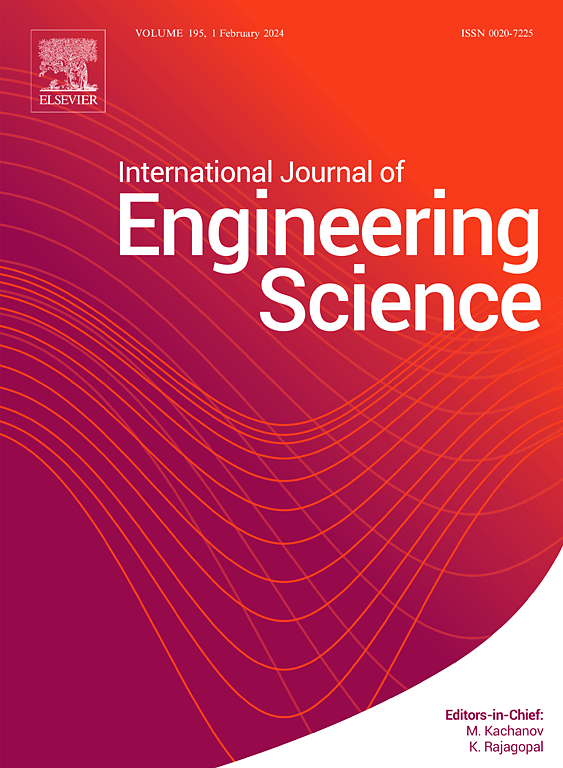Approaching and overcoming the limitations of the multiscale Capriccio method for simulating the mechanical behavior of amorphous materials
IF 5.7
1区 工程技术
Q1 ENGINEERING, MULTIDISCIPLINARY
International Journal of Engineering Science
Pub Date : 2025-08-11
DOI:10.1016/j.ijengsci.2025.104317
引用次数: 0
Abstract
The Capriccio method is a computational technique for coupling finite element (FE) and molecular dynamics (MD) domains to bridge their length scales and to provide boundary conditions typically employed in large-scale engineering applications. Earlier studies showed that strain inconsistencies between the coupled domains are caused by the coupling region’s (bridging domain, BD) resistance to spatial motion. Thus, this work examines influences of coupling parameters on strain convergence in Capriccio-coupled setups to study the mechanical behavior of solid amorphous materials. To this end, we employ a linear elastic 1D setup, imitating essential features of the Capriccio method, including force-transmitting anchor points (AP), which couple the domains via linear elastic springs. To assess the effect of more complex interactions in 3D models versus 1D results, we use an interdimensional mapping scheme, allowing qualitative and quantitative comparisons. For validation, we employ both an inelastic polystyrene MD model and a predominantly elastic silica glass MD model, each coupled to a corresponding FE material description. Our 1D results demonstrate that decreasing the conventionally high AP stiffness, along with other less significant measures, diminishes this motion resistance, revealing an optimal ratio between the material stiffness of the coupled domains and the cumulative AP stiffness. The 3D silica setup confirms that these measures ensure decent domain adherence and sufficiently low strain incompatibilities to study the mechanical behavior of elastic models. However, these measures turn out limited and may not ensure sufficient accuracy for studying the deformation and fracture behavior of Capriccio-coupled inelastic models. To overcome this, we employ a modified coupling approach, revising the Capriccio method’s AP concept by introducing a much lower so-called molecular statics stiffness during the FE calculation and a higher AP stiffness during only the MD calculation. Initial results on the 1D setup indicate that essential coupling limitations can be overcome, albeit with the risk of oscillatory strain amplifications depending on the BD’s design. This novel approach may enable a more accurate analysis of the mechanical behavior of coupled inelastic amorphous materials. We recommend evaluating its performance in 3D alongside additional methodological extensions. Overall, our results outline the current limitations of the Capriccio method and lay the groundwork for its targeted extension to study the mechanical behavior and, in particular, fracture phenomena in inelastic amorphous materials.
探讨并克服多尺度卡布里西奥法模拟非晶材料力学行为的局限性
Capriccio方法是一种耦合有限元(FE)和分子动力学(MD)域的计算技术,以桥接它们的长度尺度,并提供大型工程应用中通常使用的边界条件。早期的研究表明,耦合域之间的应变不一致是由耦合区域(桥接域,BD)对空间运动的阻力引起的。因此,这项工作考察了耦合参数对卡布里西奥耦合装置中应变收敛的影响,以研究固体非晶材料的力学行为。为此,我们采用线性弹性一维设置,模仿Capriccio方法的基本特征,包括力传递锚点(AP),它通过线性弹性弹簧耦合域。为了评估3D模型中更复杂的相互作用与1D结果的影响,我们使用了一种多维映射方案,允许定性和定量比较。为了验证,我们采用了非弹性聚苯乙烯MD模型和主要弹性硅玻璃MD模型,每个模型都耦合到相应的FE材料描述。我们的一维结果表明,降低传统的高AP刚度,以及其他不太重要的措施,减少了这种运动阻力,揭示了耦合域的材料刚度和累积AP刚度之间的最佳比例。3D二氧化硅装置证实,这些措施确保了良好的区域粘附性和足够低的应变不相容性,以研究弹性模型的力学行为。然而,这些措施是有限的,可能不能保证足够的精度,以研究变形和断裂行为的capriccio -耦合非弹性模型。为了克服这个问题,我们采用了一种改进的耦合方法,修改了Capriccio方法的AP概念,在有限元计算中引入了一个更低的所谓分子静力刚度,而在MD计算中引入了一个更高的AP刚度。1D设置的初步结果表明,可以克服基本的耦合限制,尽管根据BD的设计存在振荡应变放大的风险。这种新方法可以更准确地分析耦合非弹性非晶态材料的力学行为。我们建议评估其在3D中的性能以及其他方法扩展。总的来说,我们的研究结果概述了当前Capriccio方法的局限性,并为其有针对性地扩展到研究非弹性非晶材料的力学行为,特别是断裂现象奠定了基础。
本文章由计算机程序翻译,如有差异,请以英文原文为准。
求助全文
约1分钟内获得全文
求助全文
来源期刊

International Journal of Engineering Science
工程技术-工程:综合
CiteScore
11.80
自引率
16.70%
发文量
86
审稿时长
45 days
期刊介绍:
The International Journal of Engineering Science is not limited to a specific aspect of science and engineering but is instead devoted to a wide range of subfields in the engineering sciences. While it encourages a broad spectrum of contribution in the engineering sciences, its core interest lies in issues concerning material modeling and response. Articles of interdisciplinary nature are particularly welcome.
The primary goal of the new editors is to maintain high quality of publications. There will be a commitment to expediting the time taken for the publication of the papers. The articles that are sent for reviews will have names of the authors deleted with a view towards enhancing the objectivity and fairness of the review process.
Articles that are devoted to the purely mathematical aspects without a discussion of the physical implications of the results or the consideration of specific examples are discouraged. Articles concerning material science should not be limited merely to a description and recording of observations but should contain theoretical or quantitative discussion of the results.
 求助内容:
求助内容: 应助结果提醒方式:
应助结果提醒方式:


